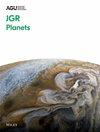Preservation Potentials of Siderite in Low-Temperature Brines Relevant to Mars
Abstract
The scarce carbonate record on the Martian surface is one of the fundamental unsolved issues for paleoclimate and environmental evolution. Whether carbonates first formed and then dissolved due to a transition in global environments or whether Mg–Fe carbonates never extensively formed due to geochemical kinetics thresholds remains unknown. In this study, we experimentally examined the preservation potential of siderite in Mars-relevant fluids, including ultrapure water, H2O2, NaClO4, NaClO3, NaCl, Na2SO4, NaHCO3, and Na2SiO3 solutions, at 277 K. The effects of the water/rock ratio at WR10 and WR100 on dissolution rates were also investigated. We found that siderite dissolution and subsequent oxidation and hydrolysis of leached Fe did not substantially acidify the solutions. The siderite dissolved relatively rapidly in the chloride and chlorate solutions and slowly in the silica or bicarbonate solutions. In a circum-neutral to slightly alkaline aqueous environment with oxidative species, the mobility of leached Fe was limited, leading to the formation of goethite or lepidocrocite, which clustered on the siderite surface. The longest lifetime of 1-mm siderite grains was found in the Na2SiO3 solution at WR100, which was estimated to range from 198 ka to 198 Ma. Water-limited, silica-rich, and oxidative aqueous environments benefit siderite preservation on the Martian surface. Our results support that the lack of voluminous siderite on Mars may be primarily due to the inhibition of its formation rather than alteration and dissolution after its presence, consistent with the recent detection of Mg–Fe carbonate at Gale Crater and Jezero Crater.

 求助内容:
求助内容: 应助结果提醒方式:
应助结果提醒方式:


